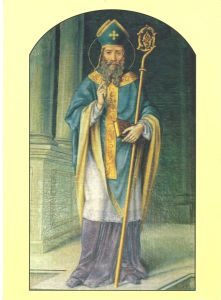Theobald was Archbishop of Canterbury from 1138 to 1161. His time at Canterbury saw the Canterbury-York division settled in Canterbury’s favour. Theobald played a role in bringing peace to the Kingdom as the Anarchy came to an end. King Stephen appointed Theobald with the blessing of the Papal Legate. The appointment of another abbot from the Abbey at Bec owing as much to Stephen’s preference not to promote his brother as to Theobald’s suitability for the role.
King Stephen appointed Theobald at a meeting at which barons, churchmen and the Papal Legate were present. This prevented any dispute over the appointments legality. The main rival to Theobald was Henry, Bishop of Winchester. Henry was King Stephen’s younger brother and it was feared that he would become too powerful given the promotion.
Henry, however, was made Papal Legate by Pope Innocent II. This gave him the right to call Church Councils and placed him on a par with Theobald. During this time there were disputes over the holding of Castles by some bishops.
Theobald and Henry of Blois became important politically during the Civil War that was fought between King Stephen and the supporters of Matilda’s claim. One or both of them would be required to crown a monarch. Following the capture of Stephen at the Battle of Lincoln both men attended to Matilda, Theobald having first met with Stephen. She was not crowned Queen though, as she did not have entry to London.
In 1148 Theobald ignored the King’s demand that he did not attend a Papal council. At the Council of Rheims many English Bishops, Henry of Blois included, were suspended by the Pope. King Stephen was not impressed and responded by seizing land from the church. This was met by the pope placing England under and Interdict. Theobald was unable to return to Canterbury but ran the church from Framlington. This posed a threat to the King and matters were resolved reasonably quickly.
A Legatine Council of 1151 spoke out about the violation of the church and stood up for the churches right to maintain it’s own ecclesiastical courts. Theobald clashed with King Stephen over this matter and again the following year. Stephen attempted to make his son, Eustace, recognised as his heir. Theobald refused to crown him as such. The invasion of England the following year by Henry of Anjou brought the succession crisis to a head. Theobald was instrumental in arranging for Henry of Anjou to be named as heir following Eustace’s death. The Treaty of Wallingford was largely due to his negotiating. He was also involved in ensuring that Stephen’s remaining son, William, was properly settled through inheriting lands.
Theobald was also responsible for increasing the influence of the Norman Church. As well as settling the Canterbury-York debate in 1148, he also oversaw the gradual acceptance of superiority from the Welsh bishoprics. All of the Welsh dioceses swore obedience to him as Archbishop of Canterbury.
The NormansFind out about the Norman monarchs and key features of Society during the Norman era from the menu below. |  |
|
| The Normans | ||
| Monarchs | ||
| William the Conqueror | William Rufus | King Henry I |
| King Stephen | ||
1066 | ||
| Claimants to the throne | Battle of Fulford | Battle of Stamford Bridge |
| The Battle of Hastings | ||
The Norman Church | ||
| Robert of Jumieges | Stigand | Odo of Bayeux |
| Lanfranc | Anselm | Ralph d’Escures |
| William de Corbeil | Theobald | Article: Anglo-Norman Church |


